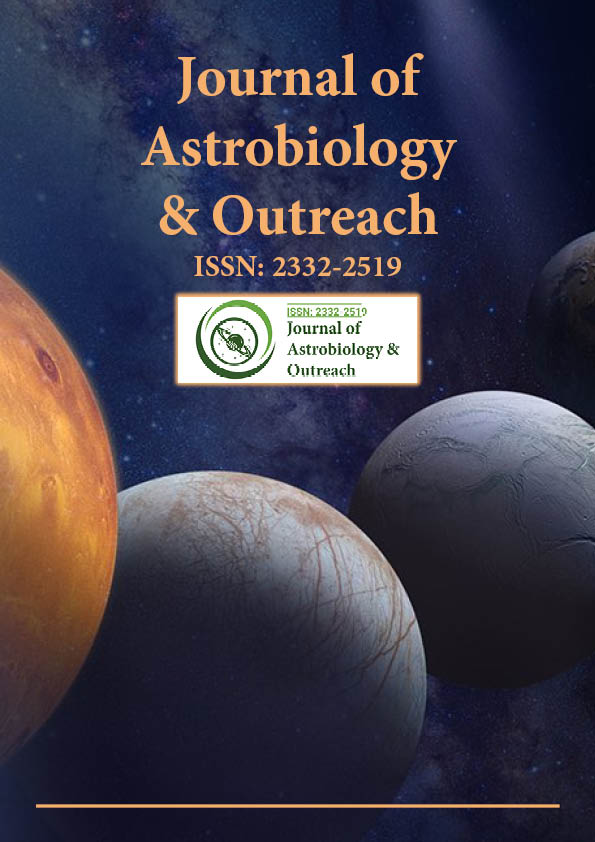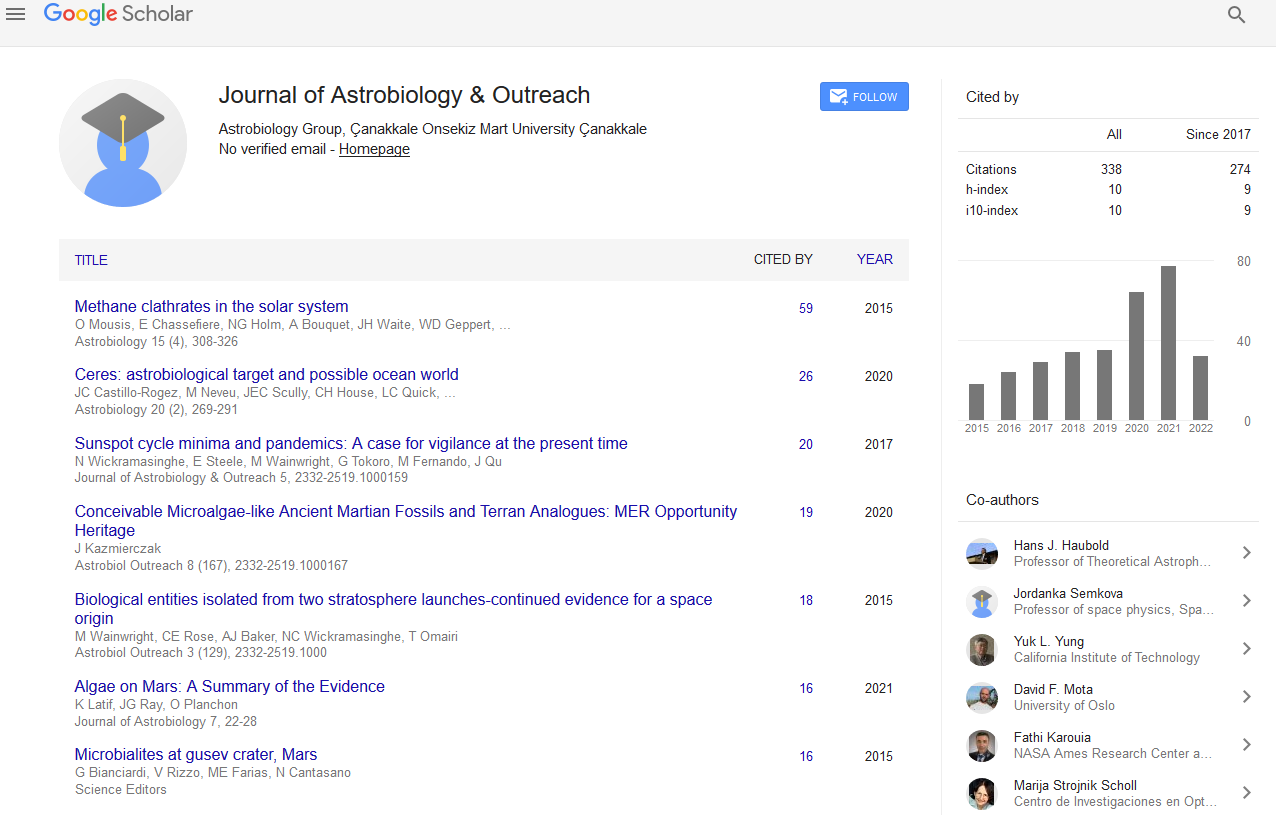Indexed In
- Open J Gate
- Academic Keys
- JournalTOCs
- RefSeek
- Hamdard University
- EBSCO A-Z
- OCLC- WorldCat
- Google Scholar
Useful Links
Share This Page
Journal Flyer

Open Access Journals
- Agri and Aquaculture
- Biochemistry
- Bioinformatics & Systems Biology
- Business & Management
- Chemistry
- Clinical Sciences
- Engineering
- Food & Nutrition
- General Science
- Genetics & Molecular Biology
- Immunology & Microbiology
- Medical Sciences
- Neuroscience & Psychology
- Nursing & Health Care
- Pharmaceutical Sciences
Short Communication - (2024) Volume 12, Issue 3
Revolutionizing Comet Studies: The Potential of Next-Generation Observatories
Marta Silva*Received: 30-Aug-2024, Manuscript No. JAO-24-27919; Editor assigned: 02-Sep-2024, Pre QC No. JAO-24-27919 (PQ); Reviewed: 16-Sep-2024, QC No. JAO-24-27919; Revised: 23-Sep-2024, Manuscript No. JAO-24-27919 (R); Published: 30-Sep-2024, DOI: 10.35248/2332-2519.24.12.360
Description
The Oort Cloud, a unique and spherical reservoir of icy bodies surrounding the Sun, serves as a repository of comets that occasionally journey into the inner solar system [1]. These "new" comets, dislodged by stellar encounters or galactic tides, provide a glimpse into the primordial conditions of the early solar system [2]. However, their time spent within the planetary region, defined as the area within 30 astronomical units of the Sun, remains a subject of significant interest in celestial mechanics and planetary science. Estimating this residence time is critical for understanding the orbital evolution of comets, their physical transformations and the potential risks they present to planets, including Earth.
New Oort Cloud comets typically enter the planetary region with highly eccentric orbits, experiencing interactions with the Sun and the major planets, especially Jupiter and Saturn [3]. These gravitational perturbations play a dominant role in determining the fate of the comets. Some are ejected back into interstellar space, while others may be captured into shorter-period orbits or destroyed due to close approaches to the Sun or planetary collisions. Non-gravitational forces, such as those arising from cometary outgassing, add further complexity to their trajectories.
Numerical simulations have shown that the residence time of new Oort Cloud comets in the planetary region is relatively brief, typically ranging from a few tens to hundreds of years. The short duration is a result of the strong gravitational influence of the giant planets, particularly Jupiter, which acts as a "gatekeeper" to the inner solar system. Close encounters with Jupiter can lead to significant changes in a comet's orbital energy, often resulting in rapid ejection from the solar system or capture into a more stable orbit [4].
The perihelion distance, or the closest approach of a comet to the Sun, is an important factor influencing its residence time. Comets with perihelia closer to the Sun are more likely to undergo increased sublimation, leading to greater activity and potential fragmentation [5]. These processes, combined with gravitational interactions, contribute to the rapid dynamical evolution and eventual removal of the comet from the planetary region.
The limited residence time of new Oort Cloud comets significantly impacts their physical characteristics. Prolonged exposure to solar radiation within the planetary region accelerates the sublimation of volatile ices, leading to the loss of surface material and changes in the cometary nucleus [6]. This process can result in the formation of a dust mantle, reducing the comet's activity over time. Comets with shorter residence times, however, are more likely to retain their pristine composition, providing unique opportunities to study unchanged material from the early solar system.
These physical changes are not just relevant to understanding the nature of individual comets but also provide insights into the broader processes of solar system evolution. By analyzing the transformation of comets over time, researchers can infer the conditions and dynamics that prevailed in the early stages of planetary formation.
The study of residence time also has practical implications for planetary defense. New Oort Cloud comets, with their high velocities and unpredictable orbits, present a distinct challenge to impact risk assessment. Their brief presence in the planetary region often limits the time available for detection and tracking, emphasizing the need for strong observational systems. Understanding their motion and residence time within the solar system improves our ability to predict their trajectories and evaluate potential risks [7-9].
Despite progress in modeling the residence time of Oort Cloud comets, uncertainties remain due to the chaotic nature of gravitational interactions and the limited observational data available for these objects. Upcoming advancements in survey technologies, such as the Vera C. Rubin Observatory's Legacy Survey of Space and Time (LSST), are expected to transform our understanding of these enigmatic bodies. By providing more comprehensive data on their orbits and activity, these efforts will refine residence time estimates and contribute to a deeper understanding of the dynamics of the outer solar system [10].
Conclusion
In conclusion, the residence time of Oort Cloud new comets in the planetary region is an important parameter in understanding their dynamical and physical evolution. These estimates provide critical insights into the interactions between comets and the planetary system, informing our understanding of solar system history and forming strategies for planetary defense. As observational capabilities advance and numerical models grow more precise, the study of these cosmic travellers provides significant potential to reveal the processes that form the solar system's evolution and the nature of its most ancient materials.
References
- Ito T, Higuchi A. An estimate of resident time of the Oort Cloud new comets in planetary region. Planet Space Sci. 2024;253:105984.
- Wajer P, Rickman H, Kowalski B, Wiśniowski T. Oort Cloud and sednoid formation in an embedded cluster. II. Dynamics and orbital evolutions. Icarus. 2023;410:115915.
- Kaib NA, Quinn T. Sedna and the Oort Cloud around a migrating Sun. Icarus. 2011;215(2):491-507.
- Fernandez JA, Ip WH. Time-dependent injection of Oort cloud comets into Earth-crossing orbits. Icarus. 2011;71(1):46-56.
- Meech KJ, Pittichová J, Bar-Nun A, Notesco G, Laufer D, Hainaut OR, et al. Activity of comets at large heliocentric distances pre-perihelion. 2009;201(2):719-739.
- Ootsubo T, Watanabe JI, Kawakita H, Honda M, Furusho R. Grain properties of Oort cloud comets: Modeling the mineralogical composition of cometary dust from mid-infrared emission features. Planet Space Sci. 2007;55(9):1044-9.
- Jenniskens P, Estrada PR, Pilorz S, Gural PS, Samuels D, Rau S, et al. Properties of outer solar system pebbles during planetesimal formation from meteor observations. Icarus. 2024;423:116229.
- Brasser R, Duncan MJ, Levison HF, Schwamb ME, Brown ME. Reassessing the formation of the inner Oort cloud in an embedded star cluster. Icarus. 2012;217(1):1-9.
- Poppe AR. An improved model for interplanetary dust fluxes in the outer solar system. Icarus. 2016;264:369-86.
- Machado JT, Mehdipour SH. Multidimensional scaling analysis of the solar system objects. Commun Nonlinear Sci Numer Simul. 2019;79:104923.
Citation: Silva M (2024). Revolutionizing Comet Studies: The Potential of Next-Generation Observatories. J Astrobiol Outreach. 12:360.
Copyright: © 2024 Silva M. This is an open-access article distributed under the terms of the Creative Commons Attribution License, which permits unrestricted use, distribution, and reproduction in any medium, provided the original author and source are credited.

